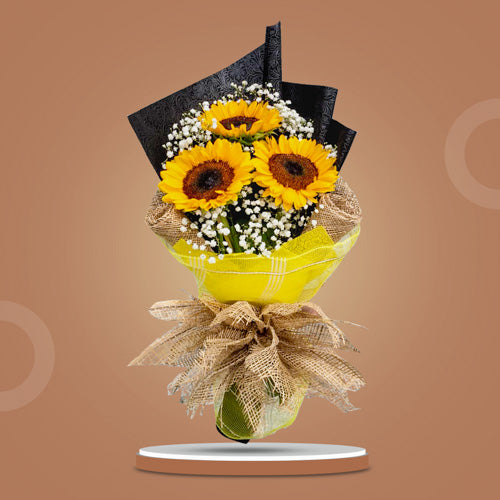A Brief History of Tulips
The amazing history of this flower, from its humble origins as a 'simple' wildflower.
While the origin of the tulip story does not begin in Holland, it certainly has a significant connection to the country. Tulips are actually native to Central Asia. However, when it comes to cultivated and commercially available bulb blooms, many of them are now associated with Holland. It's important to understand that the ancestors of these bulbs did not originate in Holland. For instance, wild dahlias can be traced back to Mexico, amaryllis to South America, freesias and callas to South Africa, and various lilies to China, Japan, and North America. These wild forms of flowers differ significantly from the garden flowers that have been developed through extensive hybridization by Dutch experts.
From the dry hillsides to the Turkish court to the hybridizers and investors in Holland
The "wild" tulips, encompassing approximately 150 different species, can trace their ancestral homeland to the Pamir Alai and Tien-Shan Mountain Ranges. These regions are situated near the present-day border between Russia and China. While they primarily thrive in areas extending from China to Spain and France in the west, they can also be found in arid regions of Central Asia. The diverse range of habitats reflects the adaptability of tulips in different climates and landscapes.
Tulips were glorified by the Turks long before the Dutch did
The origins of tulips can be traced back to the Ottoman Empire, commonly referred to as the Turkish Empire. It is more accurate to say that the early botanists of the Ottoman Empire showed a great interest in tulips long before Europeans did. The cultivation of tulips by the Turks dates back to around 1,000 AD. However, the reach of their influence extended far beyond the boundaries of present-day Turkey. Tulips eventually spread from regions that are now part of Russia, including the Black Sea area, Crimea, and the steppes north of the Caucasus, all of which were formerly under the rule of the Ottoman Empire.
The Tulip’s Tale
Legend has it that in Turkey, there was a prince named Farhad who was deeply in love with a beautiful woman named Shirin. When he received news of her untimely demise, he was overcome with grief. In his despair, he mounted his beloved horse and plunged to his death over a precipice. It is said that from each drop of his blood, a scarlet tulip sprouted, forever making the flower a symbol of pure and passionate love.
During the glorious days of the Ottoman Empire, the Sultans held the tulip in high regard, associating it with wealth and power. There is a well-known myth about a Sultan who went overboard with his spending on a tulip festival, eventually meeting a tragic fate. Even before the Dutch developed their fascination with tulips, these blooms were already celebrated in the Netherlands. To this day, the tulip remains the national flower of Turkey, a testament to its enduring significance and cultural importance.
Tulips goes to Europe
In the 1500s, European explorers embarked on botanical expeditions, documenting their discoveries of various plants. Among these findings, botanical drawings of tulips started to circulate in Europe, captivating the attention of many with their beauty. One particular depiction, Tulipa bononiensis, gained popularity, along with the intriguing "flamed" tulips that were exotic to Europeans. These multicolored blossoms, now known as "Rembrandt" tulips, became subjects of fascination and caught the interest of renowned Dutch painters, including Rembrandt himself.
The tale of tulips in Holland took a significant turn with the botanist Carolus Clusius, who held the position of Hortulanus at the University of Leiden, where Western Europe's first botanical garden, the famous "Hortus," was located. Clusius had previously worked with medicinal herbs in Prague and Vienna. However, it was during his time in Vienna that his connection to tulips began. He encountered a man named De Busbecq, an envoy to Sultan Suleiman's court in Constantinople, the capital of the Ottoman Empire. De Busbecq gifted Clusius tulip bulbs from Central Asia, which he later brought with him to Holland. This marked the beginning of a significant chapter in tulip history.
Although Clusius initially focused on the scientific significance of tulips, potentially seeking medicinal applications for the bulbs, the growing ornamental floral trade in Holland sparked interest in the blooms as a lucrative source of revenue. Clusius guarded his bulbs carefully, fueling the public's desire for tulips. In fact, there was such a high demand for tulips that some were even stolen from his gardens. This marked the beginning of the famous "Tulipomania" period, characterized by a speculative frenzy surrounding tulip bulbs.
Tulipomania: The historic rise and fall of the "great tulip craze"
Once a few tulip bulbs escaped Clusius' careful oversight, they became highly sought-after rarities, regarded as extremely valuable. The establishment of a trade market in the early 1600s led to a surge in prices. The allure of hybrid tulips grew, and the limited supply of certain bulbs became immensely valued by the wealthy, who were willing to pay exorbitant prices. In 1624, a single bulb of a specific tulip variety, with only 12 bulbs available, fetched a staggering price of 3000 guilders per bulb, equivalent to roughly $1500 today. (It's quite remarkable to think that a comparable "Rembrandt" tulip bulb can now be purchased for just 50 cents!) In another notable sale, a single bulb was sold for the equivalent of $2250 along with a horse and carriage.
The excitement surrounding tulips persisted into the 1630s, with notarized bills of sale for bulbs and rampant fraud and speculation. However, in 1637, disaster struck. Many wealthy traders were suddenly impoverished overnight, and the tulip market experienced a dramatic collapse. Prices eventually stabilized at more reasonable levels. Nevertheless, the genuine admiration for the stunning beauty of tulip blooms remained unaffected. Since then, the industrious Dutch have established one of the world's most organized manufacturing and export businesses for flower bulbs. Each year, approximately nine billion flower bulbs are produced in Holland, with around seven billion of them being shipped for a total export value of $3 billion. According to the Netherlands Flower Bulb Information Center, the United States is the largest importer of Dutch bulbs, with an annual import value of $130 million (wholesale).



